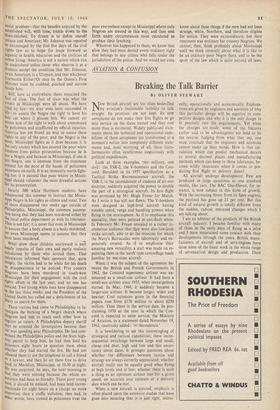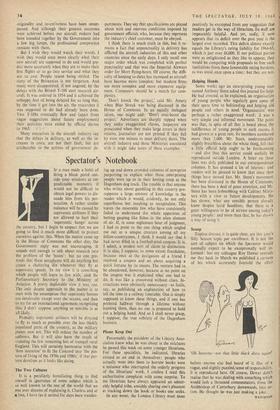AVIATION & CONFUSION
Breaking the Talk Barrier
By OLIVER STEWART
NEW British aircraft are too often bedevilled by aviation's inalienable inability to talk straight. Its promises are not kept. Its new aeroplanes do not make their first flights or go into service on the dates named and they cost more than is estimated. Widely publicised state- ments about the technical and operational capa- bilities of these aeroplanes are transformed at a moment's notice into completely different state- ments and, most worrying of all, these trans- formations often synchronise suspiciously with political expediencies.
Look at three examples, two military, one civil: the TSR-2, the V-bombers and the Con- cord. Heralded in its 1957 specification as a Tactical Strike Reconnaissance aircraft, the TSR-2, to the astonishment of students of air-war doctrine, suddenly acquired the power to double the part of a strategical aircraft. Its first flight was promised by Mr. Hugh Fraser for March. As I write it has still not flown. The V-bombers were designed as high-level aircraft having notable speed, range and handling powers when flying in the stratosphere. As if to emphasise this speciality, they were painted in anti-flash white. In February Mr. Fraser revealed to a rather in- credulous audience that tliey were also low-level strike aircraft, able to do the missions for which the Navy's Barracudas were laborously and ex- pensively created. As if to emphasise their amazing new versatility, a start was made on re- painting them in the `earth' type camouflage made familiar by war-time aircraft.
When it was the subject of the agreement be- tween the British and French Governments in 1962, the Concord supersonic airliner was an- nounced as a small-size airliner. It had been a small-size airliner since 1955, when investigations started. In May, 1964, it suddenly became a larger-size airliner. It became longer, wider and heavier. Cost estimates given in the financial papers rose from £170 million to about £250 million. Then there is the service date. In pro- claiming 1970 as the year in which the Con- cord is expected to enter service, the Ministry of Aviation, in a statement dated November 19, 1962, cautiously added: `or thereabouts.'
It is bewildering to see this intermingling of strategical and tactical capabilities; these incon- sequential switchings between large and small, cheap and dear, high and low and this uncer- tainty about dates. It prompts questions about whether the differences between 'tactics and strategy are always correctly appreciated; whether aircraft really can be equally good when flying at high levels and at low; whether there is such a thing as an optimum airliner size for a given speed, an accurate cost estimate or a delivery date which can be met.
When a new aircraft is mooted, emphasis is often placed upon the extensive studies that have gone into ensuring that it is just right, techni-
cally, operationally and economically. Explana- tions are given by engineers and scientists of why this particular design will be superior to com- petitive designs and why it is the only design to fit precisely into the requirements. Yet when the changes are made, some of the features earlier said to be advantageous are held to be the reverse. Judging from what they say, one must conclude that the engineers and scientists cannot make up their minds. How is that cal- culation which can predict mechanical details to several decimal places and manufacturing methods which can keep to those tolerances, be- come wildly inaccurate when it comes to pre- dicting first flight or delivery dates?
All aircraft undergo development. Few are produced in large quantities as one standard model, like cars. The BAC One-Eleven, for in- stance, is now subject to this form of growth. With the increasing thrust from its Spey engines, the payload has gone up 21 per cent. But this kind of natural growth is totally different from the sudden, radical, enforced changes which I am talking about.
I am an admirer of the products of the British aircraft industry. I became familiar with many of them in the early days of flying as a pilot and I have maintained some contact with their developments through the years. British manu- facturers of aircraft and of aero-engines have done some of the finest work in the whole range of aeronautical design and production. Their originality and inventiveness have been unsur- passed. And although their greatest successes were achieved before our aircraft makers had been kneaded together by the Government into a few big lumps, the professional competence remains with them.
But I wish they would watch their words. I wish they would state more clearly what their new aircraft are supposed to do and ,would pre- dict more accurately when they are to make their first flights or to go into service and what they are to cost. People resent being misled. The story of the Britannias is not forgotten. And many were disappointed, if not angered, by the delays with the Bristol T-188 steel research air- craft. It was ordered in 1954 and it achieved the unhappy feat of being delayed for so long that, by the time it got into the air, the researches it was supposed to do had already been done. Two T-188s eventually flew and (apart from vague suggestions about future employment) their activities were ended by official decree in 1963. . • Many executives in the aircraft industry say that the delays in delivery, as well as the in- creases in costs, are not their fault, but are attributable to the actions of government de- partments. They say that specifications are played about with and onerous conditions imposed by government officials who, because they represent the industry's chief customer, must be obeyed.
I think there is much truth in this, but it re- mains a fact that unpunctuality in delivery has afflicted the aircraft industries of this and other countries since the early days. I only recall one major order which was completed with perfect punctuality and that was the Imperial Airways order for Short flying-boats. Of course, the diffi- culty of keeping to dates has increased as aircraft have become more complex; but modern firms use more complex and more expensive equip-. ment. Computers should be a match for com- plexity.
'Don't knock the project,' said Mr. Amery when Blue Streak was being discussed in the House of Commons. In an equally inelegant idiom, one might add: 'Don't over-boost the project.' Advertisers are sharply rapped when they make 'exaggerated claims, taxpayers are prosecuted when they make large errors in their returns, journalists are not printed if they fail by even one minute to meet delivery dates. The aircraft industry and those Ministries associated with it might take notes of these examples.











































 Previous page
Previous page